
Oleaceae, also known as the olive family, is a taxonomic family of flowering shrubs, trees, and a few lianas in the order Lamiales. It presently comprises 28 genera, one of which is recently extinct. The extant genera include Cartrema, which was resurrected in 2012. The number of species in the Oleaceae is variously estimated in a wide range around 700. The flowers are often numerous and highly odoriferous. The family has a subcosmopolitan distribution, ranging from the subarctic to the southernmost parts of Africa, Australia, and South America. Notable members include olive, ash, jasmine, and several popular ornamental plants including privet, forsythia, fringetrees, and lilac.

Jasmine is a genus of shrubs and vines in the olive family of Oleaceae. It contains around 200 species native to tropical and warm temperate regions of Eurasia, Africa, and Oceania. Jasmines are widely cultivated for the characteristic fragrance of their flowers. A number of unrelated plants contain the word "jasmine" in their common names.

Philadelphus (mock-orange) is a genus of about 60 species of shrubs from 3–20 ft tall, native to North America, Central America, Asia and (locally) in southeast Europe.

Gelsemium sempervirens is a twining vine in the family Gelsemiaceae, native to subtropical and tropical America: Honduras, Guatemala, Belize, Mexico, and southeastern and south-central United States. It has a number of common names including yellow jessamineor confederate jessamineorjasmine, Carolina jasmine or jessamine, evening trumpetflower, gelsemium and woodbine.
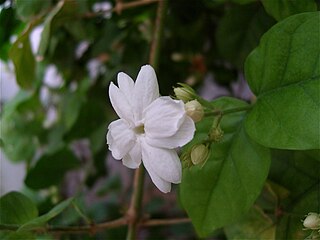
Jasminum sambac is a species of jasmine native to tropical Asia, from the Indian subcontinent to Southeast Asia. It is cultivated in many places, especially West Asia, South Asia and Southeast Asia. It is naturalised in many scattered locales: Mauritius, Madagascar, the Maldives, Christmas Island, Chiapas, Central America, southern Florida, the Bahamas, Cuba, Hispaniola, Jamaica, Puerto Rico, and the Lesser Antilles.

Jasminum nudiflorum, the winter jasmine, is a slender, deciduous shrub native to China. The flower's blossoming peaks right after winter, which is why it is also named Yingchun (迎春) in Chinese, which means "the flower that welcomes Spring". It is widely cultivated as an ornamental and is reportedly naturalized in France and in scattered locations in the United States.

Jasminum polyanthum, the many-flowered jasmine or pink jasmine, is a species of flowering plant in the olive family Oleaceae, native to China and Myanmar. A strong evergreen twining climber, it is especially noted for its abundant, highly fragrant pink to white flowers.

Mandevilla laxa, commonly known as Chilean jasmine, is an ornamental plant in the genus Mandevilla of family Apocynaceae.

Jasminum grandiflorum, also known variously as the Spanish jasmine, Royal jasmine, Catalan jasmine, Sicilian jasmine, is a species of jasmine native to South Asia, the Arabian peninsula, East and Northeast Africa and the Yunnan and Sichuan regions of China. The species is widely cultivated and is reportedly naturalized in Guinea, the Maldive Islands, Mauritius, Réunion, Java, the Cook Islands, Chiapas, Central America, and the Caribbean.It is closely related to, and sometimes treated as merely a form of, Jasminum officinale. The plant is known as "saman pichcha" or "pichcha" in Sri Lanka.

Plumeria rubra is a deciduous plant species belonging to the genus Plumeria. Originally native to Mexico, Central America, Colombia and Venezuela, it has been widely cultivated in subtropical and tropical climates worldwide and is a popular garden and park plant, as well as being used in temples and cemeteries. It grows as a spreading tree to 7–8 m (23–26 ft) high and wide, and is flushed with fragrant flowers of shades of pink, white and yellow over the summer and autumn.

Stephanotis floribunda syn. S. jasminoides, the Madagascar jasmine, waxflower, Hawaiian wedding flower, or bridal wreath is a species of flowering plant in the family Apocynaceae, native to Madagascar. It is a twining, sparsely branched liana that can measure up to 6 m in length.

Euryops pectinatus, the grey-leaved euryops, is a species of flowering plant in the family Asteraceae, endemic to rocky, sandstone slopes in the Western Cape of South Africa.
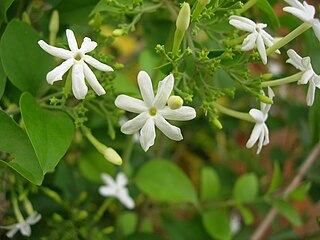
Jasmine is considered the queen of flowers and is called the "Belle of India" or the "Queen of fragrance" as it is exquisitely scented to soothe and refresh. In different parts of India it is called by different names—Mogra, Motia, Chameli, Malli puvvu, Jaati, Mulla, Mallige, Juhi, Mogra or Moonlight in the grove. It is reported that there are 300 varieties of jasmine. It is also stated that jasmine crossed the seas—from Asia to Europe, landing first along the Mediterranean Sea, conquering Greece and Turkey, reaching Western Europe through Spain, then France and Italy and finally landing in England in the latter part of the 17th century..

Jasminum officinale, known as the common jasmine or simply jasmine, is a species of flowering plant in the olive family Oleaceae. It is native to the Caucasus and parts of Asia, also widely naturalized.
Jasminium abyssinicum is a species of jasmine, in the family Oleaceae.
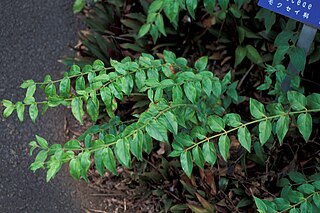
Jasminum multipartitum, the starry wild jasmine, African jasmine, or imfohlafohlane, is a species of jasmine, in the family Oleaceae, that is native to Southern Africa.

Jasminum humile, the Italian jasmine or yellow jasmine, is a species of flowering plant in the family Oleaceae, native to Afghanistan, Tajikistan, Pakistan, Nepal, Burma (Myanmar), the Himalayas and south west China. The species is widely cultivated and reportedly naturalized in Greece, Sicily and the former Yugoslavia.
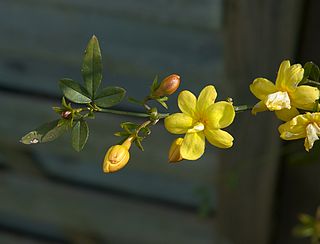
Jasminum mesnyi, the primrose jasmine or Japanese jasmine, is a species of flowering plant in the family Oleaceae, native to Vietnam and southern China. It is also reportedly naturalized in Mexico, Honduras and parts of the southern United States.
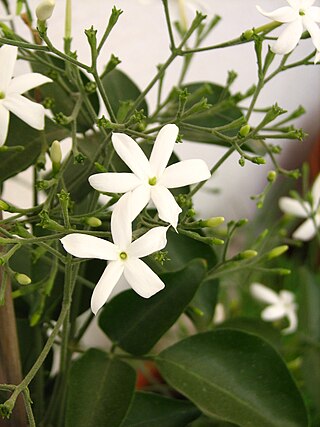
Jasminum azoricum, the lemon-scented jasmine, is a species of flowering plant in the olive family. It is an evergreen twining vine native to the Portuguese island of Madeira. The compound leaves consist of 3 bright green leaflets. The fragrant white star-shaped flowers appear in panicles from the leaf axils in summer, evolving from deep pink buds.

Jasminum laurifolium, the angel-wing jasmine, is a species of flowering plant in the genus Jasminum, native to the Himalayas, Nepal, Assam, Bangladesh, Tibet, south-central and southeast China, Hainan, Myanmar, and Thailand. Its putative form Jasminum laurifolium f. nitidum has gained the Royal Horticultural Society's Award of Garden Merit.



















